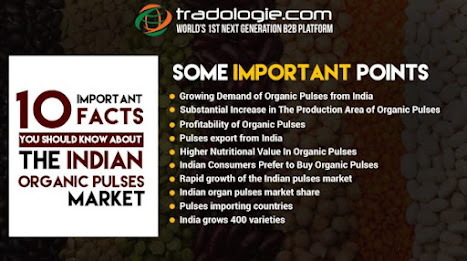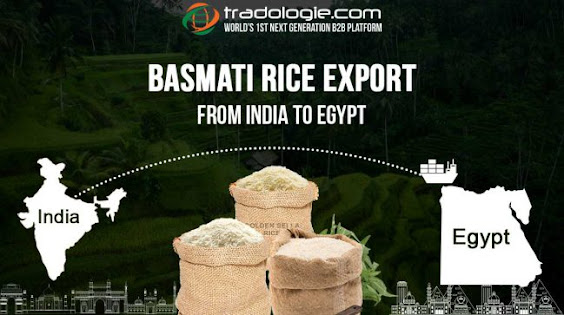10 Important Facts You Should Know About The Indian Organic Pulses Market
India is one of the largest producers and consumers of organic pulses in the world. With an estimated annual
production of 22 million tonnes, India is one of the largest producers of
pulses in the world. While Canada and Australia produce pulses for export,
India produces pulses primarily to meet domestic demand.
However, even with such a large production, Indian consumers are
faced with a shortfall of over 4 million tonnes of pulses every year. Thus,
domestic demand for pulses is met through imports from other countries like
Turkey, Myanmar, and Canada.
In recent times, there has been a marked increase in consumer
preference towards organic foods due to growing awareness about health benefits
associated with it as well as concerns over adulteration and pesticide residue
in conventional foods. Organic foods are also gaining popularity among
consumers who value purity and freshness along with taste and quality.
The Indian organic pulses market is at a nascent stage
but offers significant growth opportunities due to an increase in consumer
preference towards organic foods coupled with government support and
initiatives over the past couple of years. The following infographic highlights
key facts about the Indian organic pulse market:
1. Growing Demand of Organic Pulses from India
India is the world’s largest producer and consumer of cereals.
It produces 30-35% of the world’s pulse crop, with a domestic consumption rate
of 24 million tons per year. Currently, India consumes around 0.5 million tons
of organic pulses annually, but this number will likely increase in the future
because of rising consumer awareness and changing consumption patterns in
India.
2. Substantial Increase in The Production Area of Organic Pulses
The area under cultivation for organic pulses increased
significantly over previous years as more farmers adopted organic farming
practices to maximize their profits. In 2001, only 50000 hectares were used for
organic picture cultivation which increased to 4 lakh hectares in 2015. The
area under organic picture cultivation is expected to grow by 50% by 2020 to
meet the growing demand for organic food products globally.
3. Profitability of Organic Pulses
The profitability of organic pulse farming has been increasing
significantly over the last decade as more farmers adopted this practice. The
profit margins for producing organically grown pulses is about an average of
US$700 per hectare as compared to an average of US$200 profit on conventional
pulse farming. Organic food products have always commanded a price premium and
this is a major reason why farmers have switched to organic pulse farming.
4. Pulses Export from India
India has exported 7,620,000 tonnes of pulses during the period
April-February 2017-18, which is higher by 1,611,000 tonnes than the number of
pulses exported during the whole of last year, according to official data.
In value terms, pulses exports from India were USD 1,749 million
during April-February 2017-18 as against USD 1,042 million during the entire
2016-17.
During April-February 2017-18 India has exported 5,697,000
tonnes of chickpeas and other pulses (valued at USD 996 million) as against
2,220,000 tonnes worth USD 307 million in the entire 2016-17.
Similarly, India has exported 1,693,000 tonnes of pigeon peas
worth USD 702 million during April-February 2017-18 as against 663,000 tonnes
worth USD 479 million in 2016-17.
5. Higher Nutritional Value in Organic Pulses
Organic pulses are grown without using chemical fertilizers and
pesticides. As a result, they do not contain traces of harmful chemicals and
toxins that can affect the quality of the product. In addition to this, they
contain more vitamins and minerals as compared to their conventional
counterparts.
6. Indian Consumers Prefer to Buy Organic Pulses
According to a survey conducted by TechSci Research, more than
60% of the Indian population prefer buying organic pulses as compared to their
conventional counterparts. The reason for this preference is that organic
pulses are free from all kinds of chemicals and toxins that can severely damage
human health. In addition to this, they have more vitamin and mineral content
than non-organic pulses. This makes them healthier and more nutritious than
non-organic products.
7. The rapid growth of the Indian pulses market
Some of the key factors driving the growth of the Indian organic pulse market include rapid urbanization and
rising disposable incomes among consumers in India. In addition, increasing
awareness about health benefits associated with the consumption of pulses is
anticipated to boost demand for organically grown pulses over the forecast
period.
8. Indian organ pulses market share
The Indian market for organic pulses is around Rs 3,000 crore
per annum out of which the domestic market has a share of Rs 2,000 crore and
exports contribute Rs 1,000 crore. India imports organic pulses worth around Rs
6,000 crore annually and 60% of this goes to Europe and North America.
9. Pulses importing countries
Many countries are importing pulses in huge amounts. The main
importing countries are Canada, the USA, China, the Philippines, UAE, Turkey,
and many more. India is also importing pulses in large quantities.
The reason behind this import is that the production of pulses
is not enough to fulfill the demand of the country. Hence it needs to import
from other countries having good production. Among the above countries, the
United States is the world’s largest importer of pulses, with a record 873,964 metric tons (MT) of pulse imports in the
2017/18 marketing year, up 83 percent from the previous year. Most U.S. pulse
imports are yellow peas, which are used for feed use and processing into
split-pea soup and other products.
10. India Grows 400 Varieties of Pulses
India grows around 400 varieties of pulse crops, of which only
100 are being used for food and other purposes. The remaining 300 varieties are
used for medicinal purposes.
Overall, we have listed down 10 key facts that will quickly give you an idea about this industry. The organic pulses market is expected to experience a CAGR of 5.6% during the analysis period 2016-2022. There are several points outlined in the organic pulses report that can help you understand the future market trend better. So, we would conclude that the organic pulses industry is growing rapidly.
Source Url:- https://blog.tradologie.com/10-important-facts-you-should-know-about-the-indian-organic-pulses-market/




Comments
Post a Comment